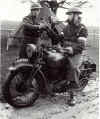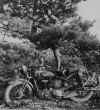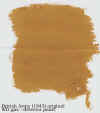|

|
Gas detector paint |
|
|
| Unit instructions stated that
the gas detector paint was to be painted onto the top of the headlight, which usually included the switch panel, the light switch and the ammeter rim (if not detached first). Also, the top of the headlight rim or blackout-mask, as appropriate, if not removed first. The idea was for the detector paint to be immediately visible to the rider in the event of a gas attack so that he
or she could take preventative action. The instructions also included the forward portion of the front mudguard, but this appears to have been rarely done in practice, only the tallest of riders being able to view this part of the bike and somewhat unnecessary if the headlight top was painted as
well. |
| |
| The paint is quite a "light" shade of brown, almost a "mustard"
colour, and in wartime black-and-white photos often looks very pale in shade when applied to bikes, etc. |
| |




 |
| Here
a few gas detector paint pictures. The two Norton pictures are taken
from an un-restored 1939 / 1940 Norton 16H found in Belgium. The gas
detector paint on the Norton show a very yellow like colour. |
| |
| When "new", the paint was very quick-drying when applied by brush, therefore dried very quickly and consequently quite thickly too (it sets like concrete). I believe this is how it was applied during
t he war by units (it was never applied by the factory) and rarely, if ever, spray-painted. The "quality" of the paint-job largely depended on the skill (and effort !) of the
artist. |
| |
Although I have never actually tried it out (!!!) from what I understand the paint is supposed to change colour in the presence of gas....what this colour is I do not know for sure, although both purple and red have been mentioned.....in Normandy one year I got stuck behind a particularly smoky diesel truck and I'm certain the paint went slightly purple in the middle of the exhaust smokescreen...!!!
What I do know, however, is that the paint does fade in sunlight after time to a very pale sand-colour, almost yellow....it also seems to be very absorbent, and in rain or wet-weather seems to revert back to it's original khaki-mustard
colour.
Remember, as with all mass-produced paint, slight shade variations do exist so any colour you can! come up with that is similar to the original sample provided would technically be
correct. |
| |
| Steve
Madden |
|